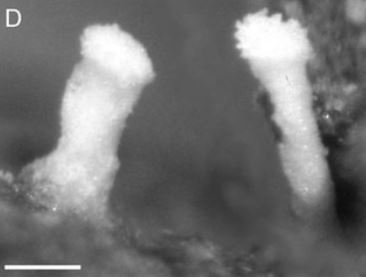Dictyocatenulata alba Finley & E.F. Morris
in Morris & Finley, Amer. Midl. Nat., 77: 201, 1967
Synonyms: Cheiromycina ananas Aptroot & Schiefelb.
Distribution:
Description: Thallus crustose, thinly episubstratic, effuse, smooth, greyish green when dry, dark green when wet, not distinctly corticate. Conidiomata stipitate synnemata, at first oval, then cylindrical, cream-coloured, 25-175 µm thick, 0.1-1.5 mm tall, simple or rarely branched, the conidiogenous zone apical, convex, pure white, sometimes enlarged and up to 0.3 mm wide, uneven when covered by conidial agglomerations, becoming concave when eroded. Hyphae of the stipe parallel, dense, hyaline, the cells 5-17 x 1-2 µm. Conidiophores arising from stipe-hyphae, up to 3 µm thick. Conidiogenous cells hyaline, smooth, when originating from the synnemata elongate-cylindrical, 5-11 x 2.5-3 µm, when originating from other conidia frequently 2-celled, each cell subcylindrical to slightly claviform, 3-6.5 x 1.5-3 µm, one of the cells acting as conidiogenous cell, the other as conidiophore, resulting in chains of several conidia. Conidia subglobose to shortly ellipsoid, muriform, mostly 10-25(-40)-celled, hyaline, 7-14(-18) x 7-11 µm, the individual cells subspherical to shortly ellipsoid, smooth, mostly 2.5–3.5 µm wide. Photobiont trentepohlioid, the cells 7-12 µm wide. Spot tests: K-, C-, KC-, P-, UV-. Chemistry: without lichen substances.Note: on the smooth bark of Acer pseudoplatanus, Betula, Fagus and Quercus, frequently at the shaded base of trunks, where it forms extensive patches not intermingled with other lichens, mainly in humid broad-leaved forests, often in valleys near a stream, rarely also on siliceous rocks. The species has a very broad, tropical to temperate distribution, being known from Canada, USA, Cuba, Panama, India, Japan, Asian Russia and Europe. Widespread and locally common in Central and Eastern Europe, but rare or perhaps absent in Western Europe. To be looked for in Italy.
Growth form: Crustose
Substrata: bark
Photobiont: green algae other than Trentepohlia
Reproductive strategy: mainly asexual, by conidia and thalloconidia

Predictive model
Growth form: Crustose
Substrata: bark
Photobiont: green algae other than Trentepohlia
Reproductive strategy: mainly asexual, by conidia and thalloconidia

Predictive model
 Index Fungorum
Index Fungorum
 GBIF
GBIF


